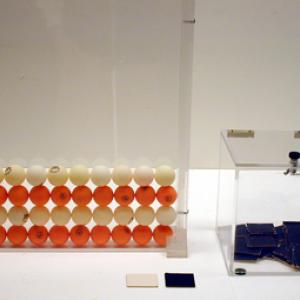College of Liberal Arts & Sciences
1A20.27 - Statistics and Probability - Ping Pong Balls
Take the box with the cards and turn them so that all one color is up. Shake the box once and see which percentage of the cards have turned over. Shake the box again and again count the percentage. The more shakes given the box, the closer to a 50:50 distribution there should be.
The ping pong balls are arranged in definite rows. Either shake or turn the box and bring it back upright and see how much of the original ordered state remains.
Disclaimer: These demonstrations are provided only for illustrative use by persons affiliated with The University of Iowa and only under the direction of a trained instructor or physicist. The University of Iowa is not responsible for demonstrations performed by those using their own equipment or who choose to use this reference material for their own purpose. The demonstrations included here are within the public domain and can be found in materials contained in libraries, bookstores, and through electronic sources. Performing all or any portion of any of these demonstrations, with or without revisions not depicted here entails inherent risks. These risks include, without limitation, bodily injury (and possibly death), including risks to health that may be temporary or permanent and that may exacerbate a pre-existing medical condition; and property loss or damage. Anyone performing any part of these demonstrations, even with revisions, knowingly and voluntarily assumes all risks associated with them.
